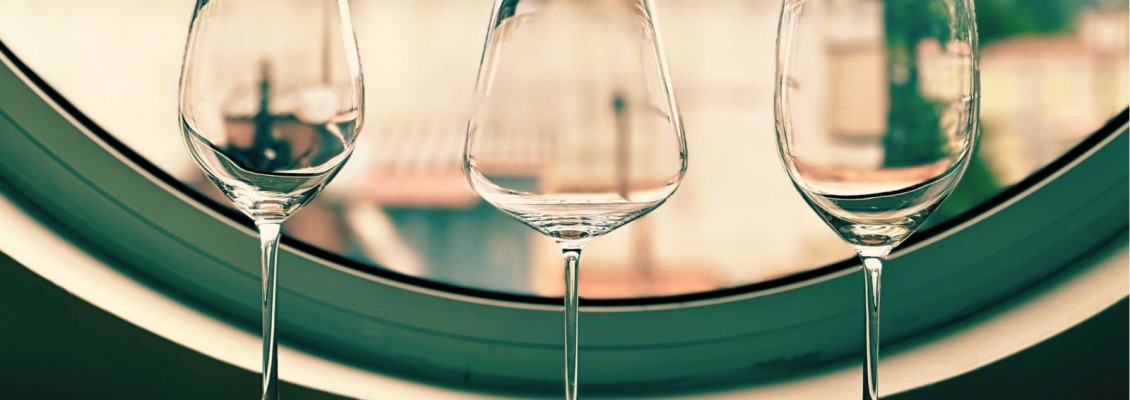The right glassware and their importance in wine: Necessity or show-off? | Stavros Moustakas Oktapodas DipWSET

The right glassware and their importance in wine: Necessity or show-off?
In a world where size and shape matters, glassware should be in the top of this list.
It is not a luxury, it is not a show-off, it is simply wine culture to seek the maximum possible pleasure from the bottle you have chosen.
Okay, one does not have to go to the point of carrying glasses from home to the restaurant like the writer, but asking for the right glass will increase your
overall experience.
Common ground for what you read below are the following:
1. The glass should have a foot, so that we can hold it from there, without our palm heating the contents, nor the fat leaving marks on it. Now if you are on a boat, we can make an exception and allow the stemless glasses that have been around lately so they don't fall and break from the wind!
2. The glass should be thin so that the whole is light and "clean" and help the overall drinking experience.
3. In harmony with the above, we prefer crystal glasses, because on the one hand they are light and on the other hand they have a smoother surface that helps the whole experience of highlighting the character of the wine.
4. We consider that the ideal amount of wine inside the tulip is up to its maximum diameter, i.e. about a third to a quarter of its total amount. The lip should definitely bend inwards. Grandma's old vintage glasses that look like funnels are totally inappropriate.
5. We said that size matters. Very small glasses will not do. Generally look for something around 250 to 350ml.
Today, the big glass manufacturers have a huge range of glass models and even categorize them by grape/wine variety! It's not a bad thing to invest in so much detail, but I think you can do your job well with just two glasses, let alone three to be even nicer.
Let's see together what they are:
1. The basic: Bordeaux type glass for all wines (except those mentioned in 2)
It is the passepartout glass, which will do its job perfectly with all whites and reds, even sparkling and sweet!
Any white that doesn't have extensive oak use will feel comfortable. Try tank Chardonnay, Sauvignon Blanc, Riesling, but also Assyrtiko, Moschofilero, Robola, and most Vidiano and Savvatiano. In this glass we will also try all the sparkling wines, and of course not the classic long and narrow flutes which, although impressive to the eye with the path of the bubbles, strip away any aromatic pleasure. Now of course if you don't have a choice, but your bubbly is something very basic, like a simple Prosecco or a tankard Muscat, with not much aromatic complexity, just go with the flute. Rosés and reds will also do well, especially those that are fresh or
slightly oaked. Bordeaux reds ( Cabernet Sauvignon, Merlot, Cabernet Franc) but also our own Agiorgitiko, fresh Mavrotragano and Kotsifali, fit perfectly in this glass. Similarly, sweet and fortified wines (sherry, port, Mavrodaphne), although they will feel better in relatively smaller glasses, will perform very decently in our basic glass as well.
2. The large, wide Burgundy-style glass
With this glass, which is larger in volume, wider and shorter than the previous one, you will find better performance in barrel-aged Chardonnay and reds that have enough tannic presence and elevated acidity, such as Nebbiolo (Barolo/Barbaresco), Pinot Noir of Burgundy, the lately fashionable Etna, and of course our Xinomavro. In general, the red varieties that promote aromatic elegance and introspection, despite the intensity and high alcohol, will feel nice in these glasses. In general, larger glasses make the wine seem less alcoholic.
3. Optionally, and only if we are looking for the detail that will make the difference, we can invest in a larger and taller than the classic Bordeaux, what some call a Syrah glass. The benefit here is seen in fuller and bulkier reds, with more alcohol, such as Syrah and Shiraz, and generally rich new world wines. Try Greek expressions of these varieties without fear, such as Cabernet from Triphyllia and Peloponnese in general, or Syrah from Crete and you will be surprised.
Tips for maintenance and storage:
1. Wash: With great care and ideally by hand. Avoid the dishwasher because the glasses have a tendency to move inside and eventually break, but they will also usually acquire smells of either detergent or food (e.g. egg)
2. Drying: Hang upside down at first, and then with the special microfiber towel, not with a common towel, which will scratch them and possibly give off odors.
3. Storage: Great care in the storage cabinet. Many of them smell dangerously strong, from varnishes to ... musty and damp.
4. Presentation: on the table never upside down, since the lip is extremely sensitive.
5. Finally if you have more than one wine to serve, ideally use another glass.
Cheers!
Stavros Moustakas Oktapodas DipWSET
About the Editor:
Stavros Moustakas-Oktapodas DipWSET has worked as a wine consultant for a large Greek import company and in addition, in strategic and communication positions for Greek wineries.
He holds the WSET Diploma, which he completed with honors, with two international scholarships (best overall performance and best performance in the blind taste exams for the academic years 2016 and 2017).
He has been a judge at the Thessaloniki International Wine Competition, the largest European competition Concours Mondial de Bruxelles, and he is Oinochoos magazine columnist.